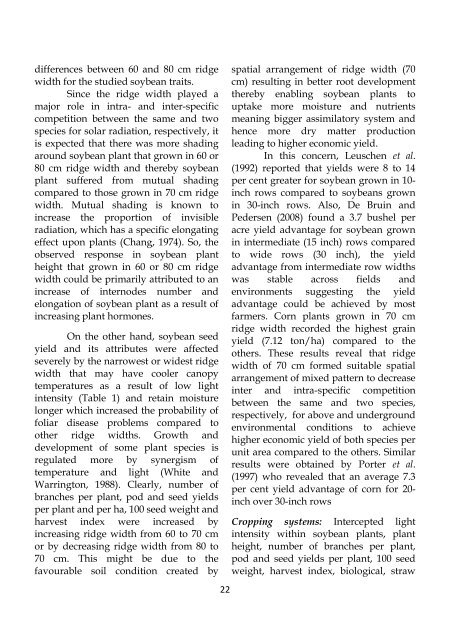SOYBEAN RESEARCH
Soybean-Research-14(2)-2016
Soybean-Research-14(2)-2016
Create successful ePaper yourself
Turn your PDF publications into a flip-book with our unique Google optimized e-Paper software.
differences between 60 and 80 cm ridge<br />
width for the studied soybean traits.<br />
Since the ridge width played a<br />
major role in intra- and inter-specific<br />
competition between the same and two<br />
species for solar radiation, respectively, it<br />
is expected that there was more shading<br />
around soybean plant that grown in 60 or<br />
80 cm ridge width and thereby soybean<br />
plant suffered from mutual shading<br />
compared to those grown in 70 cm ridge<br />
width. Mutual shading is known to<br />
increase the proportion of invisible<br />
radiation, which has a specific elongating<br />
effect upon plants (Chang, 1974). So, the<br />
observed response in soybean plant<br />
height that grown in 60 or 80 cm ridge<br />
width could be primarily attributed to an<br />
increase of internodes number and<br />
elongation of soybean plant as a result of<br />
increasing plant hormones.<br />
On the other hand, soybean seed<br />
yield and its attributes were affected<br />
severely by the narrowest or widest ridge<br />
width that may have cooler canopy<br />
temperatures as a result of low light<br />
intensity (Table 1) and retain moisture<br />
longer which increased the probability of<br />
foliar disease problems compared to<br />
other ridge widths. Growth and<br />
development of some plant species is<br />
regulated more by synergism of<br />
temperature and light (White and<br />
Warrington, 1988). Clearly, number of<br />
branches per plant, pod and seed yields<br />
per plant and per ha, 100 seed weight and<br />
harvest index were increased by<br />
increasing ridge width from 60 to 70 cm<br />
or by decreasing ridge width from 80 to<br />
70 cm. This might be due to the<br />
favourable soil condition created by<br />
22<br />
spatial arrangement of ridge width (70<br />
cm) resulting in better root development<br />
thereby enabling soybean plants to<br />
uptake more moisture and nutrients<br />
meaning bigger assimilatory system and<br />
hence more dry matter production<br />
leading to higher economic yield.<br />
In this concern, Leuschen et al.<br />
(1992) reported that yields were 8 to 14<br />
per cent greater for soybean grown in 10-<br />
inch rows compared to soybeans grown<br />
in 30-inch rows. Also, De Bruin and<br />
Pedersen (2008) found a 3.7 bushel per<br />
acre yield advantage for soybean grown<br />
in intermediate (15 inch) rows compared<br />
to wide rows (30 inch), the yield<br />
advantage from intermediate row widths<br />
was stable across fields and<br />
environments suggesting the yield<br />
advantage could be achieved by most<br />
farmers. Corn plants grown in 70 cm<br />
ridge width recorded the highest grain<br />
yield (7.12 ton/ha) compared to the<br />
others. These results reveal that ridge<br />
width of 70 cm formed suitable spatial<br />
arrangement of mixed pattern to decrease<br />
inter and intra-specific competition<br />
between the same and two species,<br />
respectively, for above and underground<br />
environmental conditions to achieve<br />
higher economic yield of both species per<br />
unit area compared to the others. Similar<br />
results were obtained by Porter et al.<br />
(1997) who revealed that an average 7.3<br />
per cent yield advantage of corn for 20-<br />
inch over 30-inch rows<br />
Cropping systems: Intercepted light<br />
intensity within soybean plants, plant<br />
height, number of branches per plant,<br />
pod and seed yields per plant, 100 seed<br />
weight, harvest index, biological, straw


